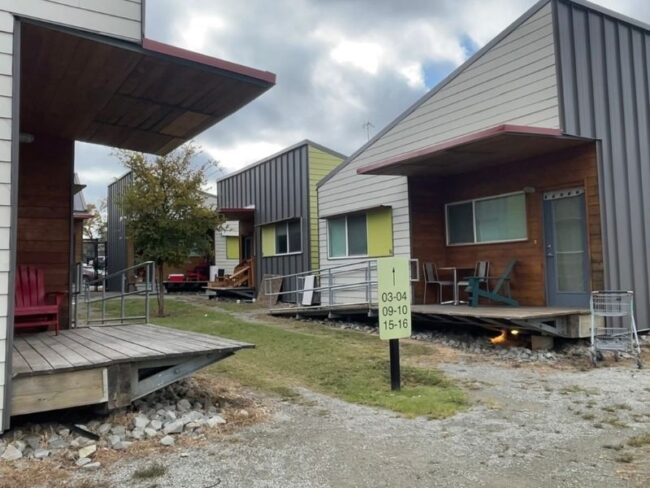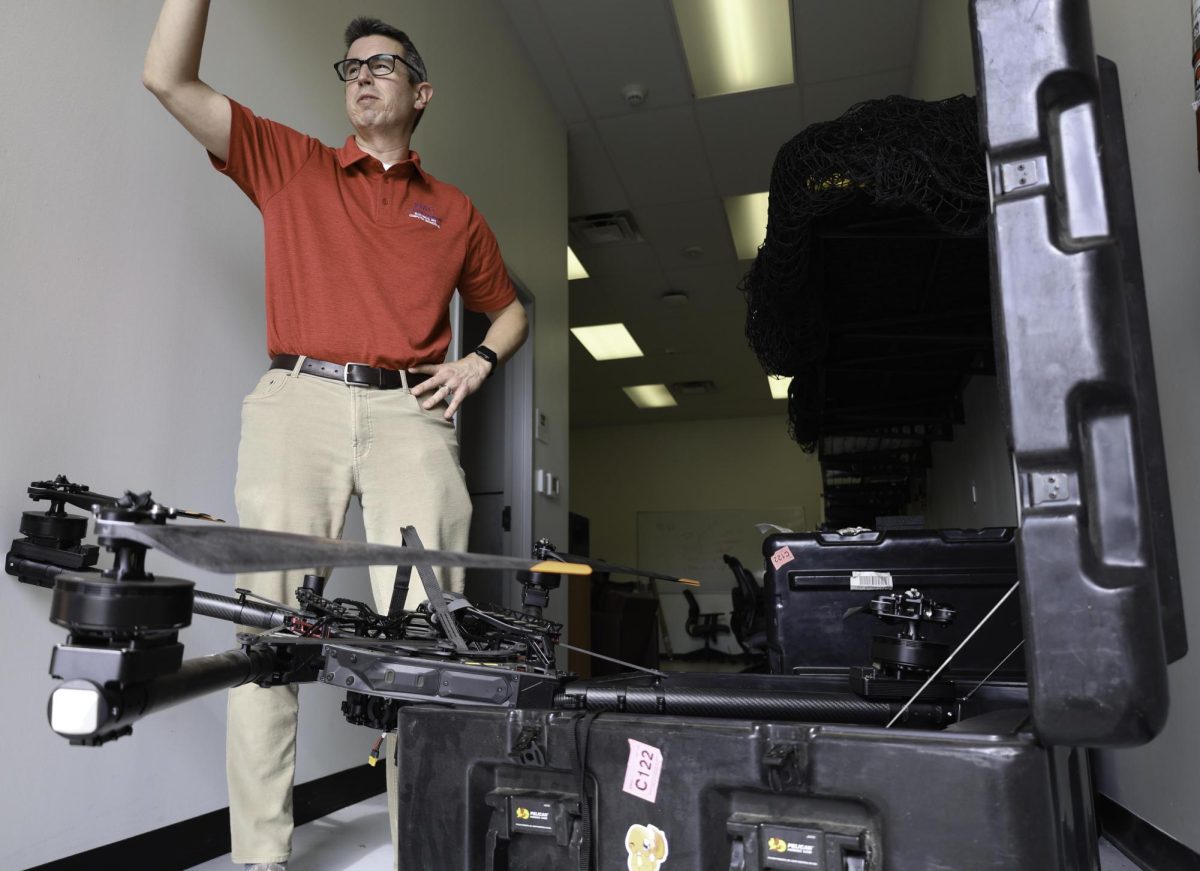By Jenny Rudolph and Audrey McClure
For Denise Ghaazee, a 430-square-foot tiny home in an experimental Dallas neighborhood has provided the space to take back her independence and find housing stability after years spent in and out of shelters.
For Terry Lantrip, a village of tiny homes in Denton County has meant following his family legacy in real estate and transforming unused farmland into a community asset.
And for Valerie Ballard, tiny homes represent an opportunity to create communities where North Texas veterans can live together in rural areas, enjoy eco-friendly options not available in the city, and practice sustainable living.
As a growing affordable housing crisis fuels rising rents and home prices, tiny homes have emerged as an appealing option for a variety of North Texans. And while even proponents admit that tiny homes aren’t going to single-handedly solve the region’s challenges with affordable housing or homelessness, they say the creative use of micro-units can serve as a source of inspiration.
“I don’t envision ever saying that tiny homes are the only solution to the housing crisis,” said John Siburt, president and CEO of CitySquare, a Dallas nonprofit which built a neighborhood of 50 tiny homes for chronically homeless residents and is now planning a community of converted shipping containers for workers. “I think those projects stir our collective imagination and add some innovation and diversity to the work.”
Rising rents, population influx contribute to housing crisis
Skyrocketing rents are perhaps the most immediate indicator of the housing crisis. According to a report released this year by the National Low Income Housing Coalition (NLIHC), to pay for a two-bedroom apartment at today’s fair market rent of $1,143 a month in Texas, a person would have to work 121 hours a week at minimum wage — or earn about $22 an hour for a regular, 40-hour work week.
Texas has seen an influx of almost 4 million people in the last decade. Many of these arrivals from pricier areas of the country are what Sandy Rollins, executive director of the Texas Tenants Union, characterizes as “new people” who can often pay more than existing residents, causing a ripple effect of displacement to occur.
Dallas faces a housing shortage of about 20,000 units, city officials estimated in 2018. And rents are more expensive here than in many other parts of Texas: the NLIHC study found that in Dallas County, a fair-market two-bedroom apartment runs $1,352 a month, more than $200 above the statewide rate.
Meanwhile, home prices are also soaring across Texas. In September, the statewide median home price reached a record of $310,000, nearly 17% higher than a year ago, according to the Texas Real Estate Research Center at Texas A&M University.
These housing costs are contributing to persistent homelessness numbers, as more people move to the streets. The latest count by the Metro Dallas Homeless Alliance found 4,570 homeless people in Dallas and Collin counties.
‘Cottages’ provide housing, services for chronically homeless
CitySquare’s neighborhood of tiny homes, The Cottages at Hickory Crossing, is nestled under the elbow of I-30 and I-75, just a stone’s throw south of Deep Ellum. It is there that Denise Ghaazee found a home nearly three years ago, after almost 16 years cycling through the shelter system.
Ghazee said her life “took a U-turn” following a divorce in 2000 and losing the home owned by her ex-husband’s family. She found herself relying on support shelters and safe houses, but never seemed to be able to fully get back on her feet.
“I was just falling victim to the streets here,” Ghaazee said. “And I’ve got all of that taken care of through the resources here…I’ve been safe here. I feel safe here. And I’ve been able to get my life back on track. Just having this place here – I don’t know what I would do if it wasn’t for this place.”
CitySquare constructed the community of 50 tiny houses in 2016 as a form of permanent supportive housing for the most vulnerable people in Dallas experiencing chronic homelessness. It is a population that often has a history of mental illnesses, jail records, and substance abuse – factors that would likely make residents unable to find housing anywhere else. The Cottages were originally built on the premise that the tax burden of leaving Dallas’ 50 most vulnerable individuals unhoused was greater than the cost of housing them.
“By our guess, through emergency room visits, police encounters and arrests, they’re costing the taxpayers of Dallas County around $40,000 per individual,” CitySquare Housing Executive Director Chad Baker said. “We can house them for around $15,000 a year, and they’re actually housed and receiving services, and not just costing taxpayers money and living on the streets.”
Shelters often require people to be sober, not have a criminal record, and have addressed their medical needs before providing them with housing. Yet CitySquare officials point out that it is nearly impossible to meet those requirements without a stable place to return to every night. The Cottages project instead takes a holistic, “zero-barriers” approach with residents by providing housing first before connecting them with medical services and counseling. Residents are then called “neighbors” and become part of the larger Cottages community.
“I found shelter, number one. Privacy to be my own person, and protection,” said Ghaazee, who plans to move into her own apartment soon. “Since I’ve been here, I’ve been to school and I’ve graduated from the CitySquare culinary school – I’m planning to eventually one day go back and finish my bachelor’s degree.”
Stable housing leads to better health, job prospects
Along with a home, the Cottages offer residents various tools for success, all tailored to guide residents to a lifestyle of self sufficiency. Data suggests the approach is working. An internal evaluation found that over three years, 54% of residents regularly attended mental health appointments, 78% saw a doctor regularly, and 94% participated in organized activities.
The project appears to have significantly lowered the rates at which residents were arrested, with 97% reporting that they were never or rarely put in jail while living at the Cottages. CitySquare officials estimate that the Cottages saved $255,723 in tax dollars over three years by reducing usage of the Dallas County Jail system.
The report also found that 80% of residents lived at the Cottages for at least six months. When surveyed, 32% of residents believed having a stable home helped improve their income and 45% believed it allowed them a much better opportunity to look for jobs.
“Whether it’s a 1% gain or a 50% gain, either way, it’s a gain, and we’re very pleased with those outcomes,” said Nadia Salibi, chief program officer at CitySquare.
Changes have been made to the Cottages in order to run more effectively. Though the initial model was to provide a home to Dallas’ 50 “hardest to house” individuals, CitySquare found that providing the services required for that level of need was unsustainable.
“We’ve kind of shifted the model some to where it’s still for the chronically homeless … but the level of severity will be distributed a little more evenly across the cottages,” Baker explained.
Building small for the veteran community
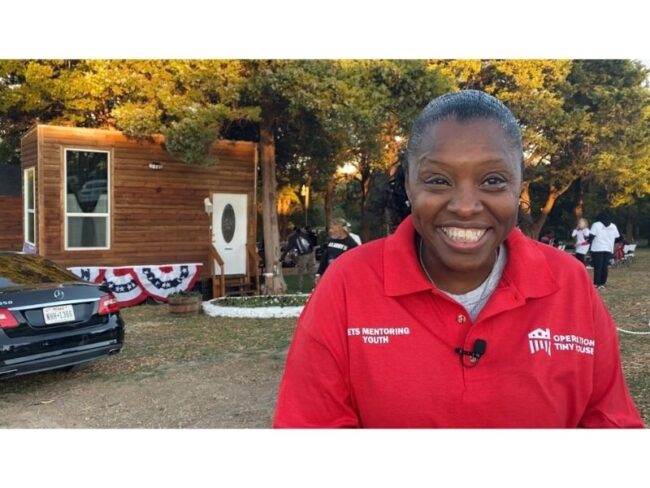
Five years ago, as Valerie Ballard’s nonprofit organization, North Texas Capacity Builders, was working to revitalize homes for veterans in Dallas, it became clear that some of the homes were uninhabitable and would be immensely expensive to overhaul.
“I told my partner, we could build them brand new tiny houses for what we’re paying to have one house totally revitalized,” Ballard said. “That’s when we decided we were gonna build tiny houses.”
By 2018, Ballard had created a new organization, Operation Tiny House, whose goal is to support homeless veterans by raising funds to build mobile tiny houses of 170 square feet or less. The organization currently has six tiny homes completed, and 52 veterans are on a wait list.
City rules require that tiny homes be connected to sewage, water, and electricity, which poses an increase in costs, Ballard said. As a result, the organization plans to develop tiny home communities for veterans in rural areas like Alvarado, south of Fort Worth. Many veterans want to live in rural, eco-friendly areas where houses are not metered, Ballard said.
Each Operation Tiny House community is made up of ten homes. The organization, which plans to develop two communities by 2022, is now raising funds by offering “tiny dining” experiences in its existing units.
A first-of-its-kind village in Denton County
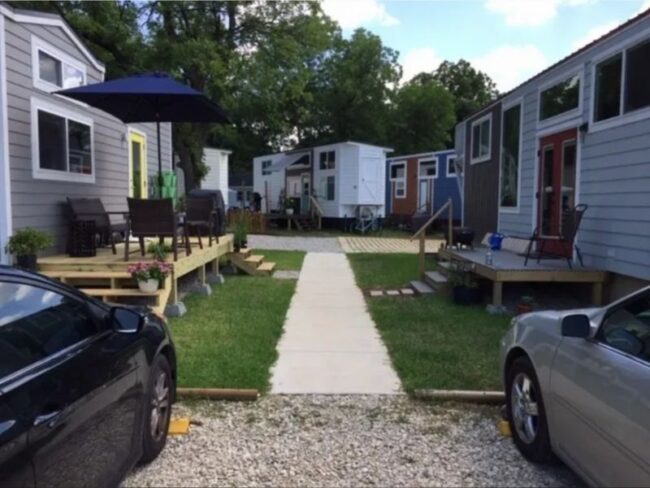
When real estate developer Terry Lantrip acquired a family farm in the Denton County city of Lake Dallas, he was unsure of what to do with his new land. Then, he saw a display of tiny homes at an Earth Day celebration: “I thought, that’s really cute — how can I incorporate that into what I’m doing?” Lantrip said.
He decided to create what is now the Lake Dallas Tiny Home Village, a curated neighborhood of 13 tiny homes on wheels, each with a maximum size of 340 square feet. The neighborhood includes a community garden, a backyard for gatherings, a large courtyard, and plenty of space for neighbors to engage with their tiny home community.
Lantrip and his management enforce strict rules for maintaining the nature of the neighborhood such as regulating noise levels, landscaping, and outer decor.
Lantrip optimistically views his village as a solution to the rising prices of houses in the DFW area. The village, Lantrip said, allows people to bring in their own tiny homes — which he said cost between $50,000 and $100,000 — and rent space in the neighborhood instead of being tied to an expensive mortgage which they are paying off for 20 or 30 years.
Commercial demand for tiny homes is growing. In fact, market research company Technavio projects that the global tiny homes market will expand by $3.33 billion in the next four years.
But while the average tiny house costs less overall than a conventional home, it is 62 percent more expensive per square foot than a regular-sized home, according to research compiled by Porch Group, a software and services firm for the home industry.
One of the biggest roadblocks in creating the Lake Dallas village was the process of obtaining permitting. Lantrip had to work with the city of Lake Dallas, which is about 30 miles northwest of downtown Dallas, to approve his neighborhood.
Lake Dallas had no regulations accommodating tiny home villages at the time. But in 2018, the International Residential Code — a list of regulations for housing requirements that cities must follow in permitting and zoning — added Appendix Q, which clarified safety standards for tiny houses under 400 square feet. For example, the appendix allows an emergency exit to be built into the roof.
Once the city of Lake Dallas adopted the new standards, Lantrip was able to break ground on the project in early 2019, making it the first tiny home village of its kind in the United States — built from scratch to take advantage of Appendix Q.
“Cities are so scared of tiny homes,” Lantrip said. “I challenge any city leader, mayor, council member, city administrators … come visit and we will show you there’s nothing to be scared about. It’s actually a very big asset to our community.”
Tiny in size — and scope?
In Dallas, which has not yet adopted Appendix Q, tiny homes on a foundation must go through the same permitting process as other constructed homes, while tiny homes on wheels are treated the same as manufactured homes, according to city staff.
Mike King, a senior planner with the City of Dallas, said the city “fully intends” to adopt Appendix Q and even consulted a draft version when approving construction of a tiny home in 2018. But King said there are significant limitations to the scope of tiny homes as an effective housing solution, especially because of their size.
“They fit well as a potential housing choice for empty nesters, single occupants, and some first-time homebuyers,” King wrote in an email. “But the occupants still must weigh their needs against the smaller scale living experience compared to the norms that most Americans expect.”
Nationally, cities from Denver to Boston to Chicago to Los Angeles have deployed small home models to address affordable housing and homelessness. Despite the benefits of the tiny house movement, two major hurdles remain: opposition from neighbors and zoning limitations.
Community opposition, also known as NIMBY, or “Not In My Backyard,” has been a major factor in halting tiny home initiatives. In Austin, for example, neighborhood opposition caused a proposed community of tiny homes for chronically homeless persons to relocate just outside the city limits.
Zoning and permitting regulations are another common impediment to the spread of the small home movement across the country. Cities frequently have zoning restrictions limiting the number of single-family residences per acre, which means that regulations must be amended for tiny home villages to be an affordable housing option.
In Dallas, navigating the approval process can be complicated and lengthy. It involves inspections to ensure that construction is permitted, has proper zoning, and meets the needs of the community, as well as the installation of the homes.
CitySquare’s Baker said a “build by right” provision that would privilege affordable housing projects could be one policy change that could help address the crisis.
“Just having some sort of foothold on ‘building by right’ would be a huge leg up for building new affordable housing,” Baker said.
Unboxing new solutions
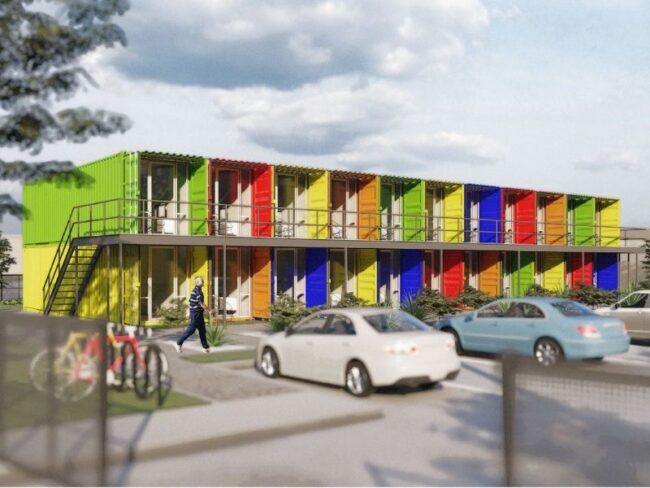
CitySquare’s next small home solution, the Lomax Container Housing Project, will be just across the street from the Cottages at Hickory Crossing – once its city permits come through.
Lomax, named for its location at the intersection of Louise Avenue and Malcolm X Boulevard, will be a community of 21 one-bedroom apartments made from repurposed shipping containers. Baker said the 300-square-foot containers are intended to help fill in the “missing middle” of affordable housing in Dallas: People who make between $30,000 and $35,000 and don’t qualify for subsidies, but are still unable to afford market rates.
Baker said the containers can provide a rare opportunity for service workers who have jobs downtown or in Deep Ellum to live and work in the same neighborhood. The goal, he said, “is to start filling in those gaps for those that just don’t have the resources or the opportunity to live anywhere near where they work.”
Executives had hoped to begin construction on the project early this year, but that timetable has been delayed. Though the project has received state approvals, CitySquare must now clear city approvals before moving forward with construction.
When it does take shape, the container project will make a tiny dent in Dallas’ affordable housing shortage. The larger issue, however, requires a variety of solutions that will involve as much policy work as project work, according to Siburt, CitySquare’s CEO.
“The Cottages, Lomax — every other development type that we try to get done is literally like one piece to a thousand-piece puzzle,” Baker added. “There is no ‘one solution.’ It’s going to take a myriad of projects to even scratch the surface of what’s needed as far as affordable housing.”
Elina Bougas, Lucy Burke, Maria Chammas, Ruth Anne Emerson and Vedang Uniyal contributed to this article.
The article was produced by students enrolled in an SMU Division of Journalism course participating in the Dallas Media Collaborative, a group of local news outlets, universities and nonprofits focused on covering affordable housing with a solutions-oriented approach. The course, Business News Seminar, was taught by Jake Batsell.



